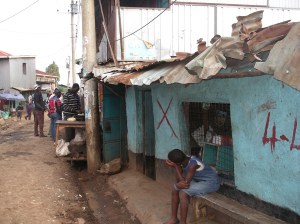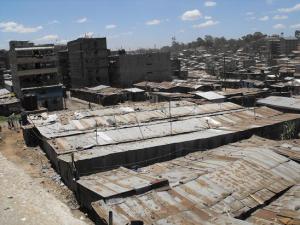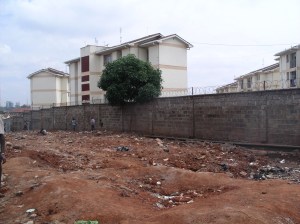Place where human cannot reach..robots can do a better job with reduce risk
Ranking Aerial Imagery for Disaster Damage Assessments
Getting a closer look at disaster in situation of hard to reach.
Source: Ranking Aerial Imagery for Disaster Damage Assessments
Development Goals in an Era of Demographic Change Global Monitoring Report | 2015/2016
Copies from: http://blogs.worldbank.org
Development Goals in an Era of Demographic Change
This year’s Global Monitoring Report, produced jointly by the World Bank and International Monetary Fund, details the progress the world has made towards global development goals and examines the impact of demographic change on achieving these goals.
The report details the decline of those living in global poverty, which is reclassified as living on $1.90 or less a day, to a forecast 9.6 percent of the world’s population in 2015 — a projected 200 million fewer people living in extreme poverty than in 2012. It also revises world economic growth projections for 2015 down to 3.3 percent on the basis of lower growth prospects in emerging markets.
The Global Monitoring Report also analyzes how profound demographic shifts could alter the course of global development. The world is undergoing a major population shift that will reshape economic development for decades. The direction and pace of this transition varies dramatically from country to country, with differing implications depending on where a country stands on the spectrum of aging and economic development, the report said.
“With the right set of policies, this era of demographic change can be turned into one of sustained development progress,” said World Bank Group President Jim Yong Kim. To accelerate gains, the report says, development policies must take into account this altering landscape. Depending on the circumstances, this means that countries need to spark their demographic transition, accelerate job creation, sustain productivity growth, and adapt to aging.
Students from Denmark write about their experiences with Kenasvit
Copies from:https://kenasvit.wordpress.com/2010/02/02/students-from-denmark-write-about-their-experiences-with-kenasvit/
The informal economy is a global phenomenon and a serious development issue around the world. Workers in the informal economy are widely neglected in terms of enjoyment of rights and formal recognition as workers. In Kenya about 70 % of the population is employed in the informal economy and they contribute as a major factor in the national economy. This has motivated us to focus our studies on how people organize to improve their situation and fight for their rights as workers.
Through six weeks in Kenya, we learned how the members are facing a range of different challenges such as land and space issues, lack of water and sanitation at the work place, harassment, lack of security and lack of political influence and representation. In this respect, KENASVIT has done a lot to improve both the relation to the authorities and the general conditions of street vendors and informal traders.
With the help of the KENASVIT National Office, we visited four of the seven urban alliances – Nakuru, Migori, Mombasa and Nairobi. We were overwhelmed by how warmly we were welcomed as students. Everywhere we went the members of KENASVIT made us feel at home and went out of their way to accommodate us.
By talking to a great number of KENASVIT’s members in their working places – streets, markets and stalls –we learned about the challenges that the informal traders face. Though workers experience challenges and possibilities different e.g. gender or tribe, many of the same issues are at stake for informal traders all over Kenya. KENASVIT has done very important work with focusing on keeping and supporting unity among traders after the post-election violence as well as encouraging women to participate in line with men. However, there is a need to enhance the structures in order to make everybody able to participate in the trajectory of KENASVIT, for example with regard to seminars, workshops and elections. These were issues that many members spoke about.
From KENASVIT’s members we also got a good impression of the way the informal traders work as civil society actors to make their voice included in the political debates and developments.
From our viewpoint, one of KENASVIT’s greatest strengths is the fact that the organisation is truly grass root based. KENASVIT has a close feeling of the local level and is capable of bringing their issues to the national and international level. That is unique in pushing for policy change and for uniting informal workers on a larger scale. This is key if the ambition is not only to improve the living conditions on a short-term scale (e.g. small-scale loans with only a limited transformative potential), but also to realize worker’s rights as well as political change as a long-term goal. Hence, communication and information among members on all levels is crucial in order to enhance a strong common voice. This being said, we were deeply impressed by the commitment, will and strength of the informal traders in coming together in a national alliance. Like one street trader told us: A good member is one who contributes, not only with member fees, but also with ideas for change.
This reflects that KENASVIT has a true potential to transform the situation for many informal workers in Kenya.
Upgrading Occupied Space: What is the National Youth Service Doing in Mathare and Kibera?
By Simon Kokoyo
The Kenyan government through the National Youth Service (NYS) has decided to improve the general living conditions in poor neighborhoods of Nairobi, namely Kibera, Mathare, Korogocho and Mukuru. These neighborhoods are known for high population density, inadequate health facilities, insecurity, unemployment and almost nonexistent garbage collection systems. The poor conditions in Kibera, Mathare, Korogocho and Mukuru can easily create an impression that there has never been government intervention or development plans for these areas and creates the temptation to address problems that seem amenable to a ‘quick fix’ like picking up garbage.
In Mathare, NYS personnel together with selected community members conducted a mapping exercise to identify needs or places that require a ‘quick fix’ such as uncollected garbage piles and blocked drainage and rivers. They are also planning to construct dispensaries, police posts, fish ponds, markets, posho mills and urban farming areas. When President Uhuru visited Mathare and said that dispensaries, police posts, markets, fish ponds, posho mills and sewer lines will be constructed creating employment opportunities for more than 3500 youths including women, everybody was happy and waiting to see the new look of Mathare and other neighborhoods earmarked for improvement. After three weeks of clearing garbage, cleaning drainages and opening rivers, questions are now emerging; do we really need the planned 12 police posts, 12 dispensaries and how did NYS team arrive at all these figures in Mathare? It has now also dawned on the community that these facilities will require space, which is currently occupied.
It is common knowledge that certain open spaces that were set aside for social amenities have been occupied or grabbed a long time ago. None of this grabbing has ever been addressed. Now, as amenities are being built, people will have to be displaced. For example in Mathare 3B, more than 500 residents have already been issued with 30 days notice by the Nairobi City County to pave way for NYS projects in Mathare or to move out of a piece of land identified for market development. In Kibera people who had occupied spaces meant for sewer lines, toilet blocks and roads were expected to vacate immediately. Some have already been displaced without compensation.
Once the NYS and some community leaders identify a piece of land for improvement or development a short notice is issued and occupants are expected to carry out a voluntary demolition and in some cases NYS locally hired youths will assist. There is lot of movement (shifting) within Kibera and Mathare, which is not painless for families, and if the intent is to improve the conditions of the poor, then these people require some support and compensation for their sacrifice for the broader community. In addition, in some place like Lindi-Kibera rents have increased after improvement on road and other social amenities. These adverse impacts of the NYS interventions on the very poor should be addressed. In the past, unless there are safeguards, slum improvements tend to drive out the poorest who are meant to benefit.
Everybody agrees that the inhumane conditions in the poor neighborhoods need to be improved urgently. However, the government should be sensitive to the fact that such communities have emerged over long period of time and as a result of certain push and pull factors common with cities experiencing rapid urbanization such as poverty, forceful eviction, conflicts, job opportunities, closeness to resources or affordable housing. Past experiences in Kenya (Mathare 4A and Kibera Upgrading Projects) show that slum or informal settlement upgrading is a complex and time-consuming process. Residents require some compensation for their losses or need to be shown alternative land for displacement to be humane and in compliance with the law. When people are moved this will impact their ability to access jobs, customers and services. It also affects children who are schooling in the area. The National Youth Service projects should think about how it is approaching evictions. It is good that the government is in a hurry to improve living conditions in poor neighborhoods, but it should go beyond the “quick fix” mentality to have a long term vision so that the amenities are staffed and financed and can have an impact on people’s wellbeing. Finally, if this initiative is to be pro-poor, the government should also be sensitive to the needs of those who will be displaced in order to improve poor neighborhoods. The government must also comply with the law in moving people which entails proper procedures and some compensation or alternative location.
Nairobi Planning Innovations is appreciative of the attention the government is paying to these poor communities. It is still important, however, to note that interventions should be compliant with both the constitution (Article 43(1)(b) which states that, every person has the right to accessible and adequate housing and to reasonable standards of sanitation) and the little known The Prevention, Protection and Assistance to Internally Displaced Persons and Affected Communities Act, 2012 which sets out guidelines for how displacement is to happen to respect the rights and dignity of the displaced.
The Key to Unlocking this African Moment
By Charles Mwangi Waituru: copied fromhttp://www.huffingtonpost.co.uk/charles-mwangi-waituru/unlocking-this-african-moment_b_6605728.html
This is a crucial moment for Africa. At the opening Intergovernmental meeting on the Post 2015 framework in New York in January I was invited to share the voices of African people with those tasked with drafting the key documents for UN member states to agree in September. These documents will replace the Millennium Development Goals agreed by member states in 2000.
Together with my colleague and former volunteer Nancy Maina, we tried to stress the importance of African communities being part of the decisions that affect their lives.
Asking people what they need
I have been part of the Participate Research Initiative which did months of consultations with people across Africa (as well as South America and Asia), documenting the perspectives of ordinary people through a series of participatory research workshops.
When grassroots communities described their realities, they taught me that the development they envisioned is not the same as the development the majority of the world imagines they want. In their own narrative, the strongest message from communities is a deep desire to be given the ability to do it for themselves.
These people identified critical blockages standing between them and their ability to function. This catalogue ranged from feeling vulnerable and excluded based on social norms, legal and political discrimination, corruption, insecurity and crime, inadequate skills and lack of opportunities to own assets. Unlocking the African moment requires removal of these blockages.
So first of all, the new development framework mustn’t just ask, “what can I do for the people?” but also “what are the people doing?” and “how can we accompany them in their local development innovation?”
Shifting focus to the often-unrecognized people like volunteer groups, grassroots community led organizations and marginalized communities will be crucial to the success of any new and ambitious plan.
Name checking the volunteers
If all the volunteers in the world were put into one country, that country would be the 9th most populous country in the world. This is not always acknowledged so I was determined to set this straight when I was given the opportunity to speak on to the UN.
I explained that for every paid member of staff that the Red Cross has globally, they have 20 volunteers. Back in sub-Saharan Africa where I come from, that figure is even greater (the Red Cross and Red Crescent have 327 volunteers for every paid member of staff). At VSO , the numbers of national volunteers supplementing the work of international volunteers in education, livelihoods, business and health have also been growing significantly in the past 15 years.
We need to name check this vital group in the new Sustainable Development Goals (SDGs). As Nancy said in her speech at the civil society forum on January 14th, both the Political Declaration and Means of Implementation Agreement that will sit alongside the Sustainable Development Goals, Targets and Indicators, must be just as sound and robust as the goals, targets and indicators we choose.
Volunteering is often the first step in people’s active participation in their communities and countries as evidenced in the inspiring 500 Ways initiative. With effective support and planning, we can mobilize the huge pool of skills, capacity and passion that volunteers have for the realization of the SDGs.
Shoulders to the wheel
Wrapping up the two day meeting, the co-facilitator, Kenya’s Ambassador to the UN Macharia Kamau, said that by September we need to have Heads of State coming to New York with real enthusiasm for this agenda. He called on us all to work together – civil society, government and academics – to tell the world why these are important and how they can be transformative. I, for one, am determined to put my shoulder to the wheel with my people so we can unlock the barriers to making this Africa’s moment.
Follow Charles Mwangi Waituru on Twitter: www.twitter.com/mwangiwaituru
Population by country – Thematic Map – TOP 50 – World
Bringing the data revolution to education, and education to the data revolution
Post2015.org - what comes after the MDGs?
Written by Pauline Rose, Professor of International Education, University of Cambridge.
Calls for a data revolution are putting the spotlight on the importance of more and better data as a means to hold policymakers to account for post-2015 goals. In many ways, education has been at the forefront of approaches to measuring progress over the past 15 years. The influence of the Education for All Global Monitoring Report (GMR) and the efforts of the UNESCO Institute for Statistics (UIS) in improving the availability of education data provide important lessons for tracking progress post-2015. This experience should play an important contribution to informing the practical next steps for the data revolution.
Building on this experience, a roundtable held at the Overseas Development Institute on 17 November brought together over 40 technical experts, who debated approaches to measuring progress towards post-2015 education targets, with a focus on learning and equity. The…
View original post 887 more words
Why statisticians should welcome the Data Revolution
Data belongs to all
Post2015.org - what comes after the MDGs?
Written by Bill Anderson, Data Standards and Systems Advisor at Development Initiatives.
“Here are two ideas of the moment:
-Monitoring the post-2015 Sustainable Development Goals (SDGs) requires a huge investment in an international framework that delivers globally compatible statistics.
-Sustainable development requires a huge investment in data collection capacity so that decision makers at national and sub-national levels have access to usable information from sustainable sources.
They are not the same thing. Herein lies the problem with Morten Jerven’s critique of the UN Independent Expert Advisory Group report on the Data Revolution.
Statistics and data are not the same. Statistics are derived from data. The more (reliable) data that exists the fewer extrapolations statisticians need to make and the more they can focus on quality and consistency within and across datasets.”
Read the full post here.
Youth well-being: measuring what matters
Post2015.org - what comes after the MDGs?
4-15 December
Wikiprogress invite you to join their online conversations on how the goal of youth well-being can be better incorporated into measurement and policy.
Context
The aim of this discussion is to map out the main issues for youth well-being and to identify organisations and initiatives working in this field. This discussion will provide the foundation for a more in-depth online debate that we will be hosting in early 2015.
Everyone is welcome to join the discussion, and we are especially interested to hear from students and young people from around the world.
There are more youth living in the world today than at any other time in human history. There are now an unprecedented 1.8 billion adolescents and young adults aged between 10 and 24, making up over a quarter of the world population (UN Population Fund). However, young people’s voices are not always heard in measurement and…
View original post 68 more words


